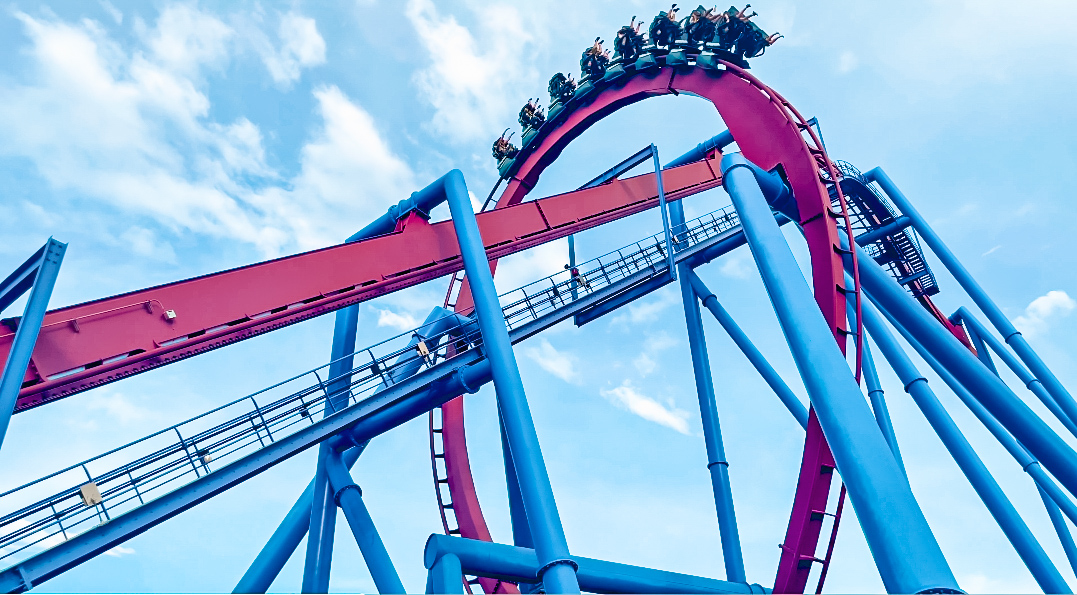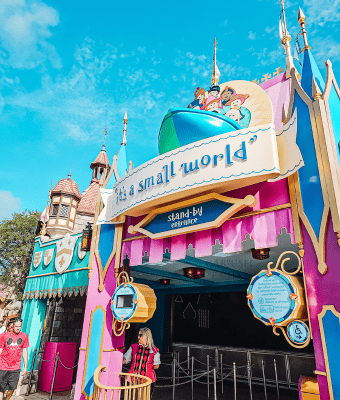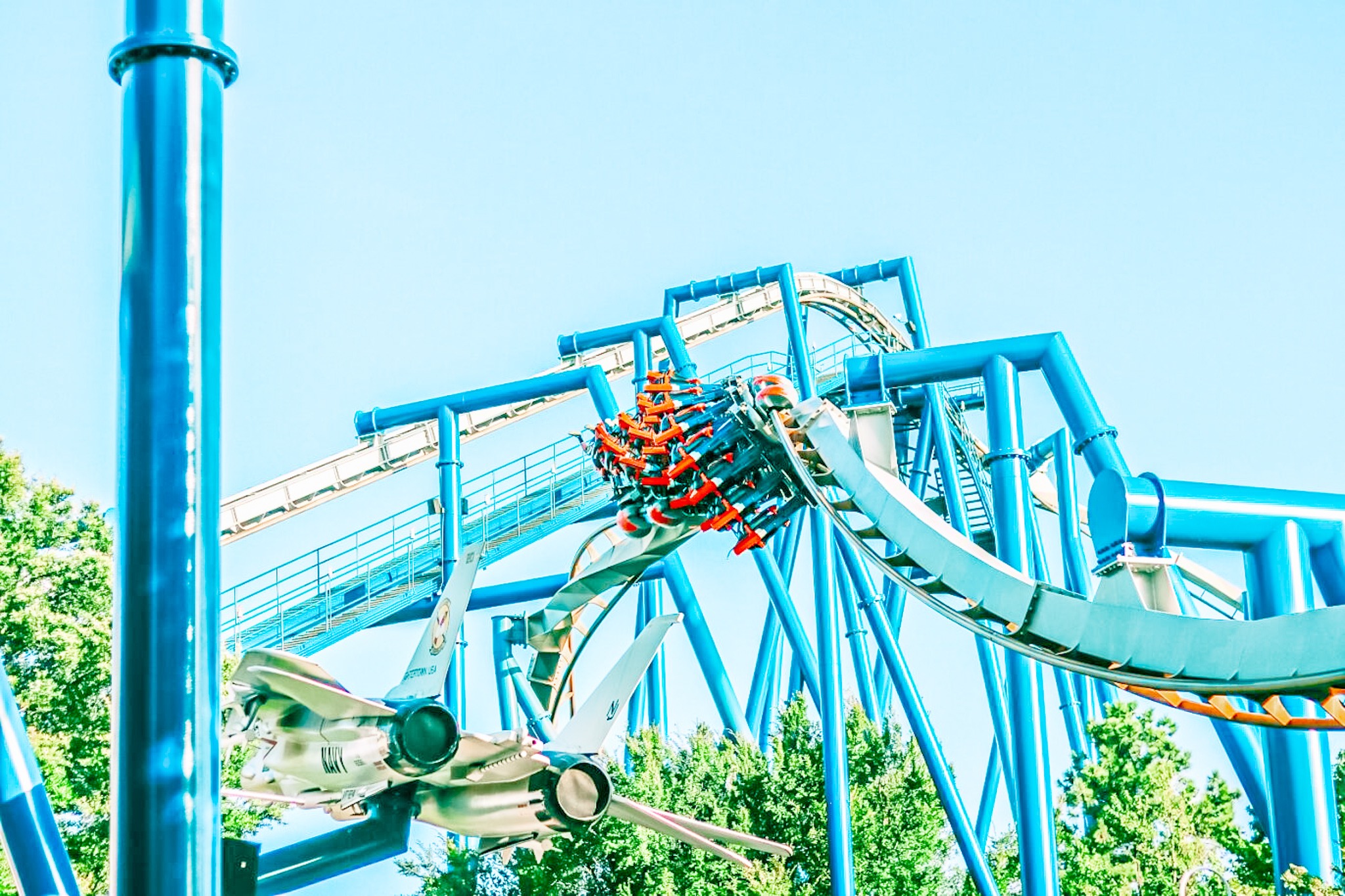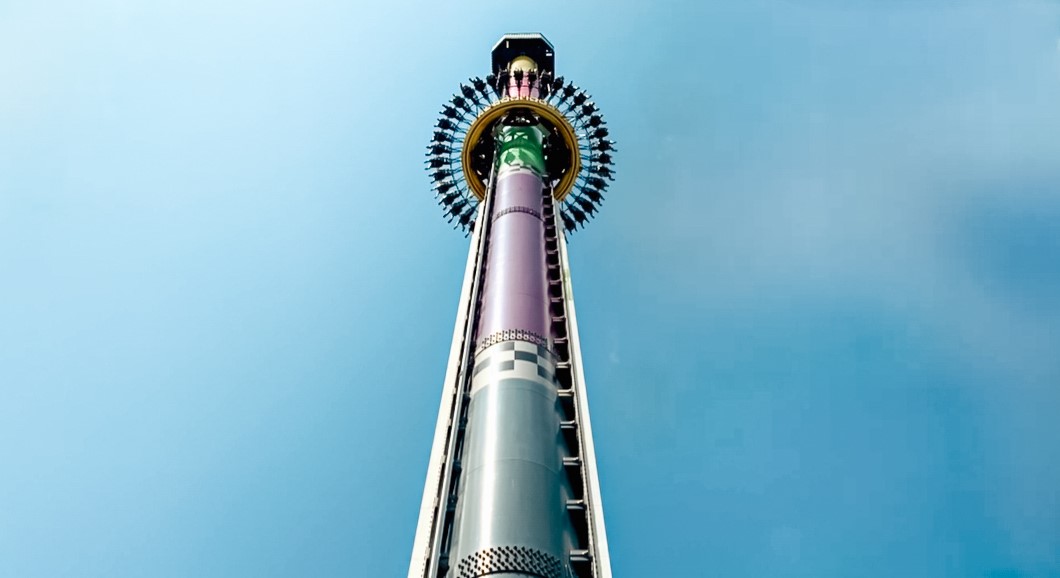Disney Abandoned Attractions: The Epcot Rhine River Cruise
{The post Epcot Rhine River Cruise may contain affiliate links that I may earn a small commission when you click on or purchase from the links. This is at no additional cost to you. All opinions are my own. You can learn more about this in my Disclosures & Disclaimers.}
SUMMARY: The German River Cruise was going to be a boat ride in the Germany Pavilion next to Biergarten. It would have included scenes of Freiburg, the Black Forest, Heidelberg & the Castle, Cologne & the Cathedral, Neuschwanstein Castle, Garmisch Ski Area, Rothenburg, Ruhr Valley, and the rivers Rhine, Tauber, Ruhr, and Isar. Other evident inclusions were Berg Eltz, Pfalz Castle, Frankfurt, Lorelei, Duesseldorf, Bonn, and Koblenz. The ride vehicles resembled classic river cruise liners, but segmented into four sections to accommodate the winding flume path. It was partially built with the rest to be completed after Epcot opened. However, lack of sponsorship has left the attraction incomplete to date.
Is there a ride in Epcot’s Germany pavilion? There was supposed to be. Once upon a time…
Before I do another deep dive on an abandoned or defunct amusement park, I want to hone in on an attraction that’s captivated me since childhood–a Disney attraction that has become something of folklore itself.
A Disney urban legend… the Rhine River Cruise.
And no, Busch Gardens fans, this isn’t for you. This one’s for Epcot purists. Or for the rogue Disney adult who’s interested in a piece of Epcot history.
A lost Disney mystery… the Rhine River Cruise.
I’ll stop with the fluff now.
The Rhine River Cruise, aka German Rivers or German River Cruise, is an old mill dark ride attraction that was destined for the Germany pavilion at Epcot. However, as evidenced by the mural covering its entrance, the German boat ride never came to be.
Its abandonment is an enigma. Multiple theories abound about why it never opened, how far into development it got, and what evidence of its partial existence is left today.
So, this here is the forgotten fairytale of Epcot’s Germany pavilion. From fabled wooden doors to exit corridors visible in Biergarten, here’s the lore and legacy of the Rhine.
It’s a tale that met a Brothers Grimm befitting end…
Finding The Rhine
Let’s start broad with this expedition along the German rivers.
The attraction of interest today was meant to find a home port in the Germany pavilion at Epcot. One of the eleven pavilions along the World Showcase Lagoon in the back of Epcot.
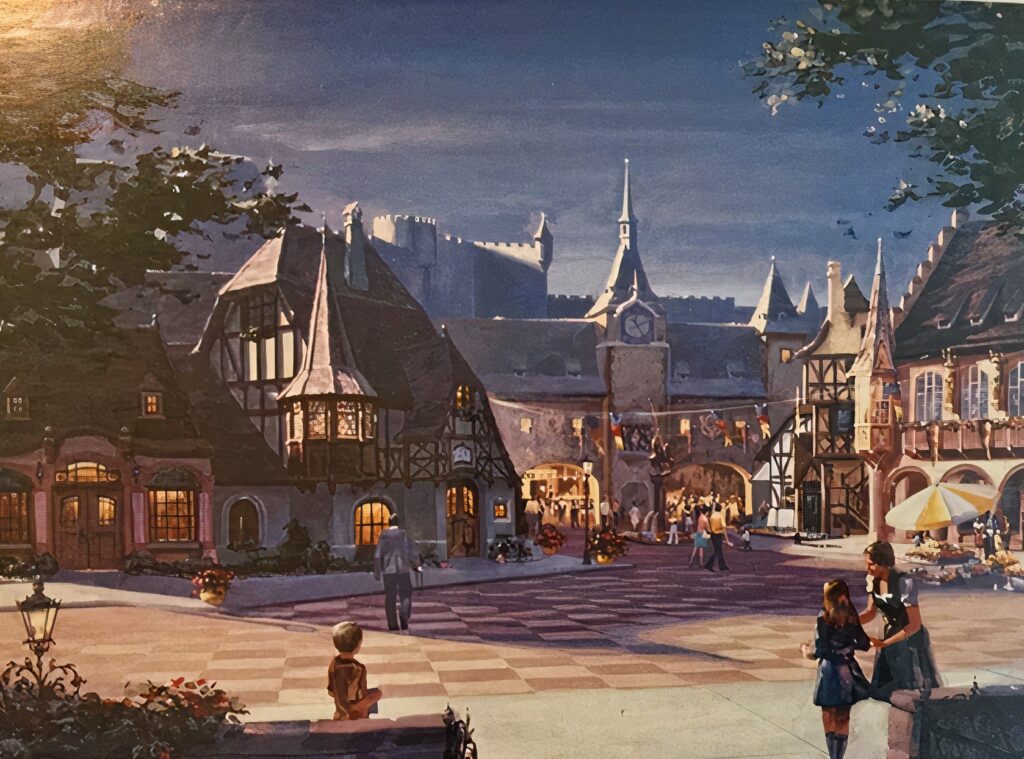
Overview of Epcot’s Germany Pavilion
Located between the China and Italy pavilions, the Germany pavilion opened in 1982 alongside eight other World Showcase pavilions at Epcot Center.
Being that Germany was split in two at the time of the pavilion’s construction and opening, it was designed to reflect different periods and regions. Resembling a German town, it features a square with a fountain and a statue of St George and the Dragon at the center. Surrounding the plaza square are a myriad of timber-framed shops, a clock tower, and the Biergarten restaurant.
Shops include Karamell Kuche, a caramel confectionery; Das Kaufhaus, miscellaneous apparel and accessories; Der Teddybar, a toy store; Die Weihnachtsecke, a year-round Christmas shop; Volkskunst, a cuckoo clocks and arts store; and Weinkeller, a wine cellar.
Sommerfest is a German quick-service eatery that’s located under the clock tower in the back of the pavilion.
Biergarten is the pavilion’s signature restaurant featuring a traditional German buffet and a live music show set in a nighttime beer garden during Oktoberfest.
The Germany pavilion also has a miniature railroad, the Romantic Road Miniature Train Village, that was added as part of the 1995 Flower and Garden Festival and has remained since.
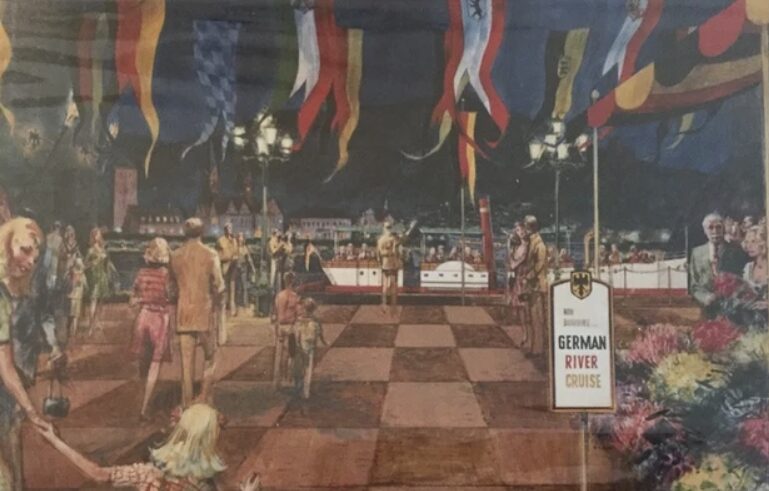
What is the Epcot Rhine River Cruise?
The Rhine River Cruise is a boat ride through Germany’s most famous rivers–Rhine, Tauber, Ruhr, and Isar–that would have passed detailed miniatures of iconic German landmarks like the Cologne Cathedral, Neuschwanstein Castle, and Black Forest.
The attraction would have taken place in a nighttime setting as it toured by lit-up miniatures placed so that they appeared to be full size from the boats.
It would have been like the Mexico pavilion’s El Rio Del Tiempo and Norway’s Maelstrom, just without the drops featured in the latter.
The ride vehicles would’ve been segmented in four parts similar to how Living with the Land’s ride vehicles are segmented in two parts. They featured a traditional white river cruise design with a tall burgundy funnel between the second and third segments. The seats in the ride vehicles faced starboard and not the bow (akin to Horizons).
It really would’ve been the German version of Living with the Land, but you could hop off at the end and eat at Biergarten. I lament.
An Imagineer’s Insights
Harper Goff was the lead for German River Cruise, but he passed away in the 90s. So, beyond the documents he left behind, there’s no way to ask him for more details about the attraction.
However, I did have the privilege to talk to another Imagineer familiar with German Rivers.
Former Imagineer Lenzy Hendrix was able to provide some more insight on the attraction:
“I walked through the show model with Harper Goff explaining the concept when I worked at Imagineering.
I specifically remember a model of Neuschwanstein Castle that was in 3 parts that the ride traveled around. All was in a nighttime setting with dayglow paint on windows and it seemed that the model actually moved on a hinge that caused a shifting of viewpoint.
Also, the castle at Heidelberg was included. It wasn’t a complete model, just to show concept, but was all in the dark… and miniatures lit and placed so they appeared full size as you’d look up at them from the river.
The boat was on wheels, not water. I seem to remember that you would never see the water so it could be dry. Hadn’t done any vehicle mock-ups to see the feel of it.
Would have been unique and exciting.”
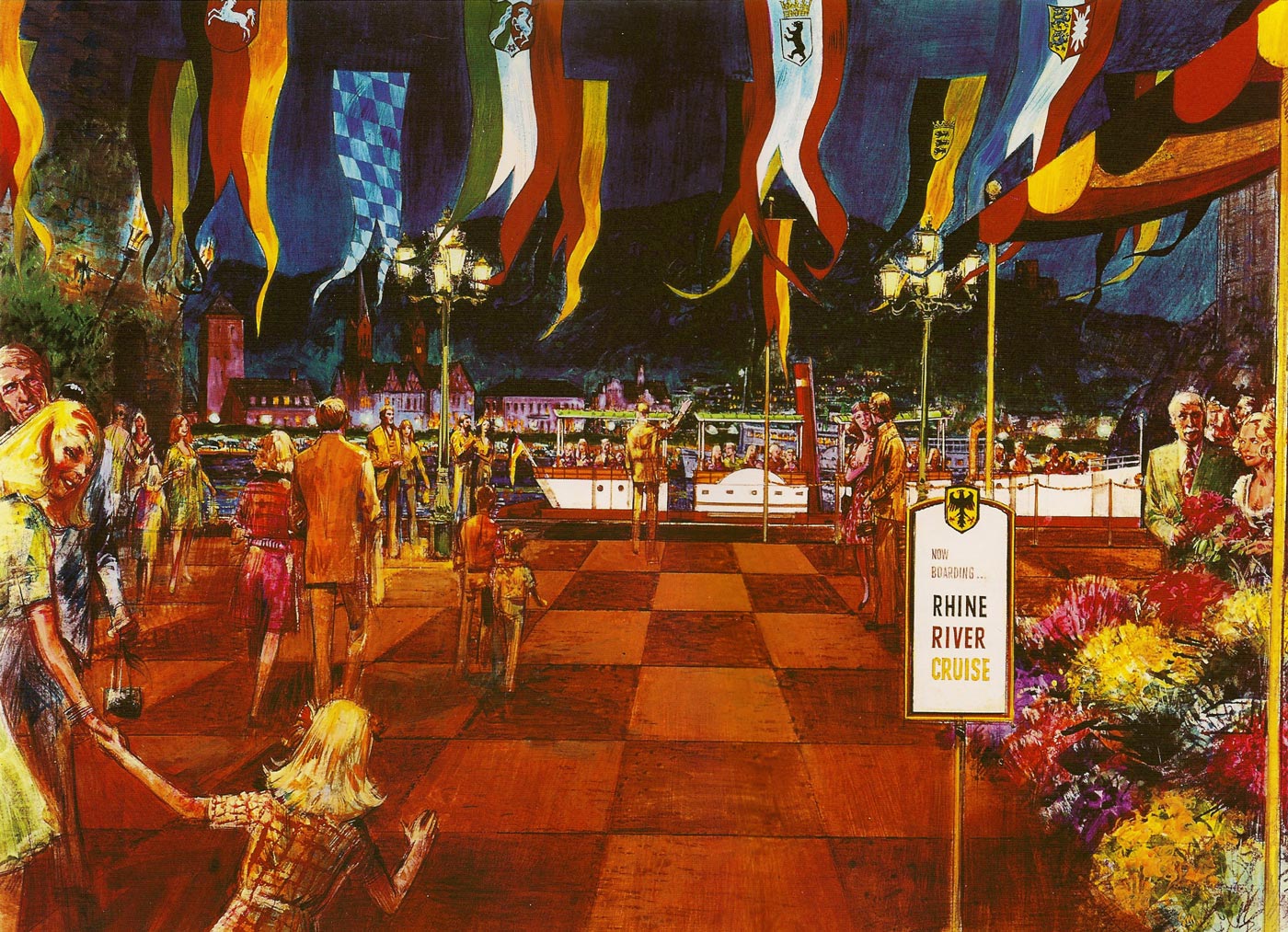
Nuances of the Name
The official name of this attraction is not what it’s now commonly referred to as.
You’ll notice that the image above is a copy of the previous image. But, there are some changes made to it.
I don’t know where this second image is sourced from–if Harper Goff or Disney themselves updated the original image or if someone else, like an enthusiast, edited the original image.
This second copy shows a more saturated look at the area as opposed to the natural color scheme Harper utilized in the original. Harper’s original would’ve been more realistic to how the scene would have looked in real life.
And with the color and clarity adjustments, some details are more clear. But, one detail in particular has been considerably changed.
The name.
Officially, this attraction’s name is actually German River Cruise, often abbreviated as German Rivers.
Every piece of media, blueprints, manuals, concept art, internal documents, and so forth confirmed to be produced by Disney has referred to this attraction as German Rivers or German River Cruise.
In all the concept art I have found, signage and entrance elements present the attraction as the “German River Cruise.” And, when the company is talking about the attraction in internal docs, press releases, and such, they refer to it as “German Rivers.”
None of the official Disney media I’ve encountered (and can recall) refers to it as the Rhine River Cruise.
And honestly, this is a detail I’ve never picked up on until I was finishing this deep dive. Despite seeing the different titles for it, I also just called it Rhine River Cruise and never thought twice about it.
This edited version of Harper Goff’s (the ride designer) original concept art is the only time I’ve seen the ride referenced as Rhine River Cruise outside of community commentary. And, this edited artwork is not confirmed to be Disney’s doing. So, this may very well be a fan edit.
If an official reference to Rhine River Cruise by Disney themselves never materializes, I’d assume that the name derives from fan colloquialism–kind of in the same vein of how Gran Fiesta Tour Starring The Three Caballeros is commonly referred to as the Donald Duck ride.
It was going to be a Rhine River cruise, so it’s been dubbed the Rhine River Cruise and likely be most commonly known as such.
And, there’s nothing wrong with that either. It’s really just semantics.
This isn’t a section to nitpick what people call it.
But, while I’m trying to comprehensively cover every factual detail about this attraction in depth (can you tell I’m going mad?), the name is an obligatory topic to cover since it’s part of the attraction’s story.
Whether you want to call the ride Rhine River Cruise, German River Cruise, or German Rivers–prost.
I’ll be referring to it as all three interchangeably in this article. But I guess to conclude: German River Cruise is Disney’s official name for this ride.

The Rhine River Experience
I’ll preface this section with: there’s a specifications manual that fully details the ride. As in, Disney could pull this out of their shelf and build it because everything’s already mapped out.
This manual, as was the attraction, was created by Harper Goff and featured blueprints, ride mechanisms, miniatures, illusions, lighting, music, sound effects, and other special effects theater-by-theater/scene-by-scene… full stop.
It further specified each town that would be represented, the different rivers, and historical landmarks. Additionally, Goff added notes and corrections throughout the manual.
This attraction was, and is, fully fleshed out.
The interiors of this document haven’t been released publicly, although there’s a chance that someday they might as its original copy was sold in an auction. A digital copy of the interior pages has been saved by the auctioneer (I’ve confirmed with Van Eaton Galleries), but has not been released either.
So, we’re going to piece this attraction together based on everything we do have that I could find. And, this includes what a former Imagineer who went through the project with Harper Goff recalls.
Putting all these puzzle pieces together, we have a good idea of what the ride experience of German Rivers would have been like.
The Queue & Loading Area
Starting off, the scenes and what we do know for certain.
Folks would have entered the attraction through the right arch of the foyer past the plaza’s square with massive wooden doors that would have opened to the attraction’s queue.
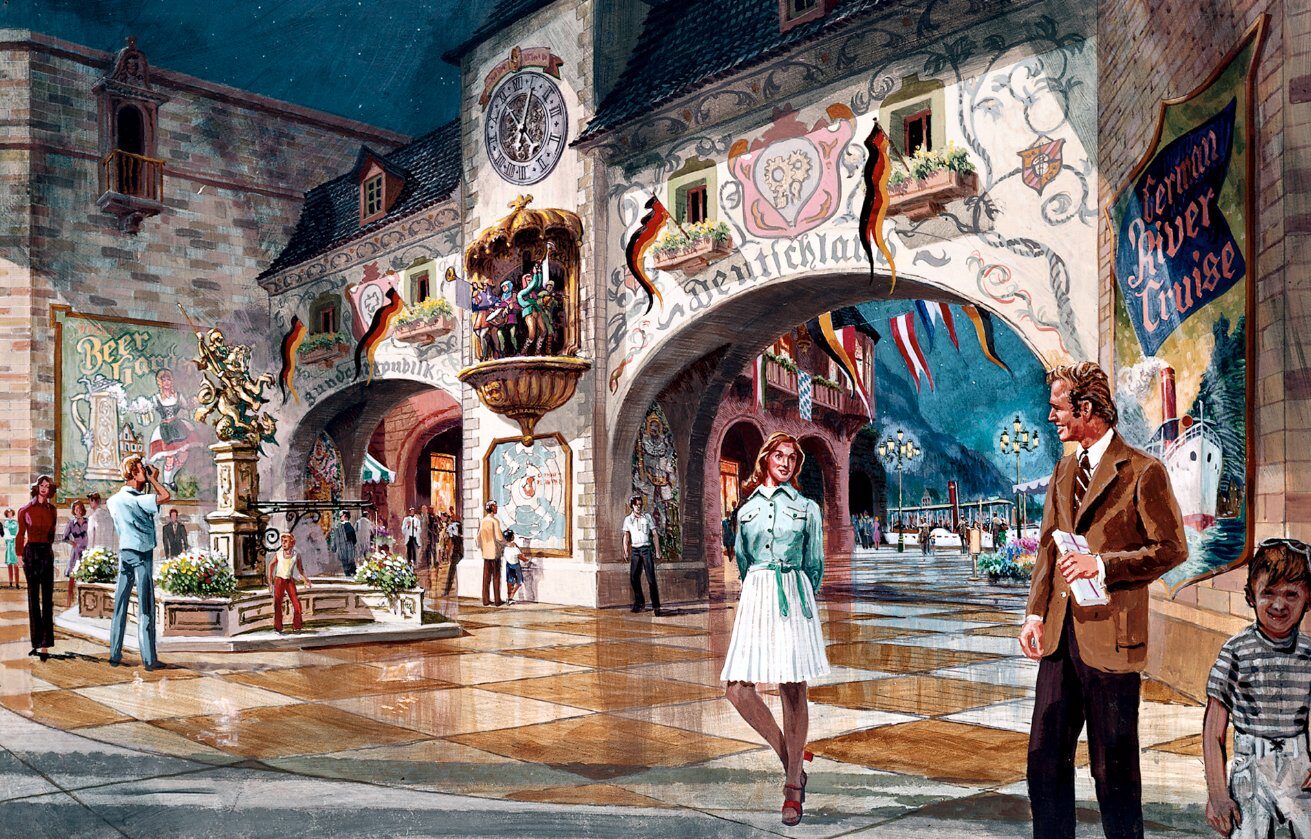
The queue would depict the dock of a river cruise at nighttime. Floors bore a checkered design, the color scheme of which varied between concept arts, but the pattern remained the same. Victorian lampposts by the “river” would help light the space, and German flag banners would hang overhead, each of which represented different regions or the country overall.
Floral arrangements would have decorated the queue area, particularly the right side where an awning resided. The coloring of the awning also changes depending on the artwork, but its design remains the same.
One angle shown in concepts has signage hanging overhead underneath the canvas of the awning.
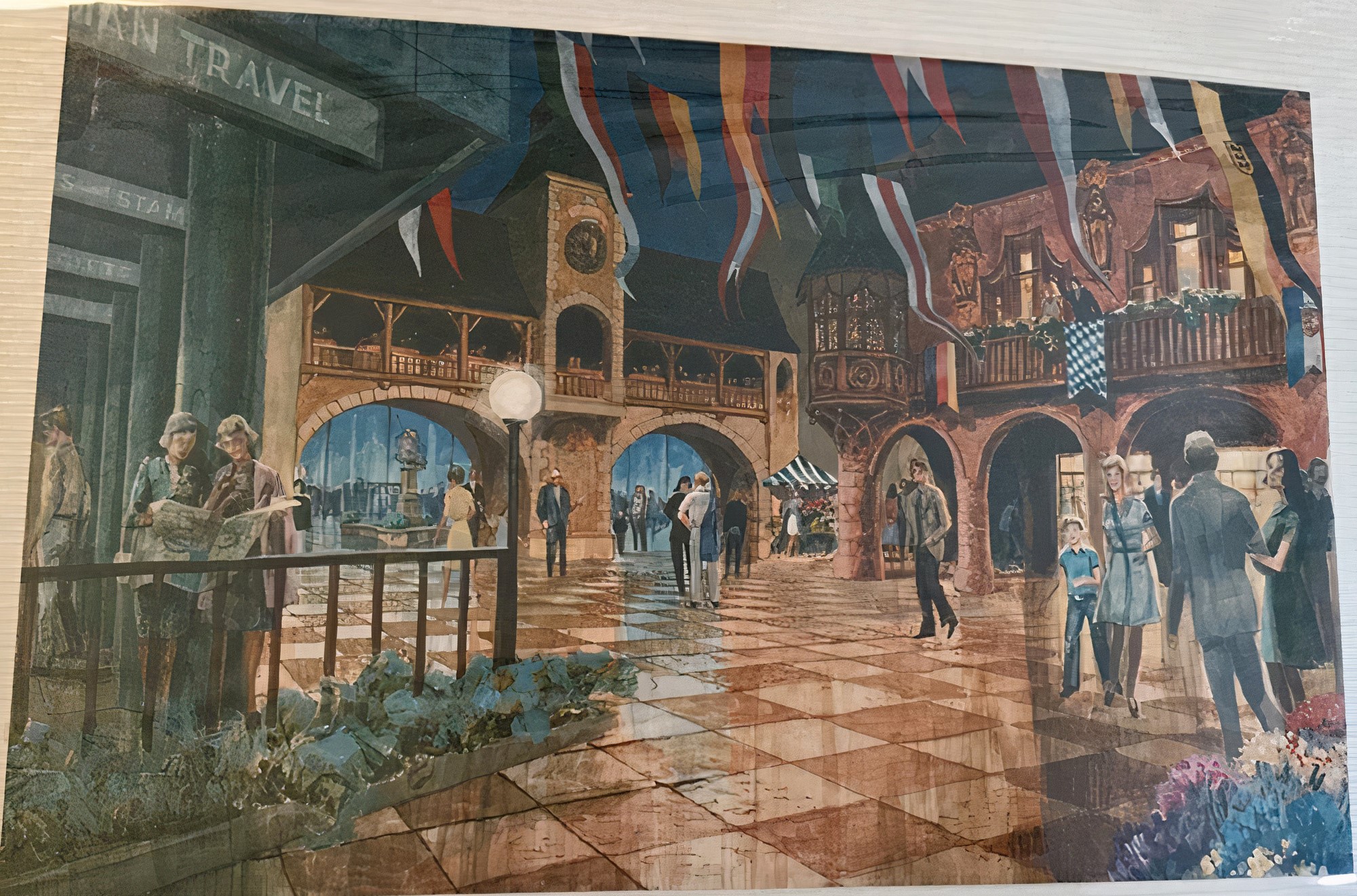
As evident in the artwork above, on the left side of the queue (opposite the awning) was a building facade that resembled the Historisches Kaufhaus in Freiburg. Despite the glowing windows, blueprints show that this space would have been what seems to be a closet or storage space.
It would have been like the facades in Biergarten, where the surroundings resemble a German village with faux windows, doors, and landscaping.
You’ll also note that the same structure is also in the outside plaza area of the Germany pavilion, where Das Kaufhaus and a Bier stand reside.

Back inside the German Rivers attraction, the setting of the entire ride was meant to take place at night (again like Biergarten).
A mural continuing the scene of the Rhine River, riverboats, and German villages would have made up the back wall opposite of the ride’s flume.

Seen on the left side of this mural is the tunnel that the ride vehicles would have emerged from after debarking the last load of passengers.
The mural wall was going to be curved so that it connected to the Freiburg Kaufhaus structure, and the stone tunnel would’ve been painted around the opening in the wall where the vessels would travel through.
Entering from that tunnel, the vessels would be inbound to the loading platform.
The quay, or loading platform of the attraction, may or may not have ended up with another, secondary, awning over it.
All of the artwork depicted so far shows no covering over where people would board the cruise.
But, one rogue snippet included in Harper Goff’s art album shows an awning running parallel with the quay and the aforementioned mural.
The mural buildings seen in the background of the potential second awning’s clip art are the ones just to the left of the bow of the river cruise ship. So, considering the placement of the mural and layout of the loading platform, that awning would likely go overhead of where guests would board the vessels.
But, this is only alluded to in this one snapshot alone. So, whether or not it would’ve been part of the final iteration of the ride isn’t clear.
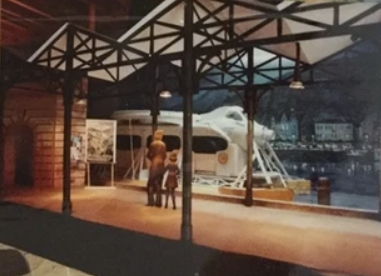
The Ride Vehicles
The ride vehicles for the Rhine River Cruise would have resembled a German river ship, sporting a design that combined the pre-1980s rivership style with old-fashioned ocean liner aesthetics.

The ride vehicles’ livery would’ve been mostly white, with a maroon stripe along the bottom at the waterline and along the top of the hull/wall/where-railing-would-be-but-there’s-not (I don’t know ship anatomy).
At the middle of the vessel would have been a maroon smokestack with a gold stripe at its top. And, a likewise gold ventilator cowl appears at the front of the vessel.
Whether the ventilator cowl is just an artistic addition for the concepts, a decorative piece that would have actually been on the vehicles, or a functioning part of a dorade box is up in the air (and possibly in that specifications manual). I’d be more inclined to believe that it was going to be a decorative piece.
What is confirmed to be an element that would’ve been on the boats is the smokestack–on which point, we’re going to talk about Living With The Land for a second again.
Tangent #1: The Rhine River Cruise’s ride vehicles would’ve been segmented like Living With The Land’s. Whereas LWTL’s vehicles are segmented into two compartments, German Rivers’ vehicles were to be segmented into four compartments.
Tangent #2: The height of the Rhine River’s vehicles probably would’ve been very similar to the height of The Land’s. I can’t find a concrete number for The Land’s vehicles, but seeing as my 6’3 brother can almost stand upright in them, I’ll suppose they’re about 6 feet tall. So, Rhine River’s likely were to be comparable considering the similar canopy overhead.
Now, what do we deduct from these two LWTL tangents?
#1: German Living With The Land (joking)
#2: The smokestack on the German Rivers vessel would’ve likely been 7 to 8 feet tall, perhaps.
In art, the funnels are taller than the people standing around the attraction. Furthermore, they’re noticeably taller than the canopy/roof on the ride vehicle compartments. As such, I’d guess upwards of 7 feet humbly.
Whether or not the smokestacks would’ve had faux smoke or fog emitting from the tops isn’t currently known. But, knowing Disney’s knack for detail (especially old-school Disney’s knack for detail despite the cost), I wouldn’t be surprised if they did.
A final line of discussion regarding the smokestacks, they were off-center of the vehicle’s width, placed closer to the port/left side so as to not hinder passenger boarding. Which is a great segue too…
Schematics.

Ride vehicle blueprints show that when in the loading quay, platforms would connect each compartment to one another. These platforms are what passengers would step on to enter the boat. And, once everyone was seated and the vessel was being prepared to disembark, the platforms would raise upwards towards the compartments.
So, in the image above, where there’s an open space to the left of the funnel for people to enter the seating area, the platform would raise back on that opening to cover it. Effectively, closing off each vehicle compartment.
In other words, the platforms are the side walls of each compartment. They turn into a floor for loading and unloading, and then they raise back up to become a wall again.
And, speaking of seating, both the blueprints above and the concept arts show that the passengers would’ve faced the starboard/right side of the boats. In this way, it’s akin to Horizons (the best attraction of all time) and Animal Kingdom’s Wildlife Express.
In the concept art below, showing one of the German River Cruise ride vehicles, the fourth compartment appears that it might have had a door that opened on the front. If so, it would undoubtedly be for wheelchairs to load onto. (Maybe the bench in that compartment would raise.)

Other details apparent in the art:
The first compartment would’ve been a roofless bow with railing along the upper edge and the cowl would’ve been on the back of this section. The second compartment would’ve been a canopy-covered passenger compartment.
The third resembled the second, save that the smokestack would’ve been on the front of this section and the ship’s name on its side. Lastly, the fourth was another canopied passenger compartment comprising of the stern, complete with a German flag hung off the back.
What seems to be like little faux windows freckle the sides of each compartment too.
As just noted and seen in the previous blueprints, the side of the third compartment bore the ship’s name, Loreley.
Loreley is the name of a Rhine river siren in German folklore that’s based on the Lorelei, a mountainous rock bank along the Rhine.
Folklore and fairytales have it that the reason for the numerous maritime accidents by the Lorelei is due to Loreley’s singing causing ships to crash on the rocks.
Legitimately, the rock formation in the passage causes a loud echo that spurs the siren mythos. And, the challenging geography of that part of the Rhine has caused many ships to wreck in that area for centuries.
Whether each of the Rhine River Cruise’s vessels would’ve bore the name Loreley or if each one was going to have its own name is (drumroll) not currently known, but presumably in the manual documents. These blueprints are but just one page that has emerged in almost 50 years. Huzzah.
But, we do know that the ride vehicles were going to bear a name of some sort. If the others had their own names, they may have been based on other Rhine folktales or other areas represented in the attraction.
The final mention concerning the ride vehicles is that the boats were going to be on wheels rather than water–something noted by Lenzy Hendrix.
He further explained that they never did any vehicle mock-ups, but that the water wasn’t going to be visible from onboard. So, the ride’s flume could have been dry or filled.
And, it’s not uncommon for most water-based attractions to have wheels on the boats.
Its A Small World, Pirates Of The Caribbean, Maelstrom, 20k Leagues, Jungle Cruise–all have wheels, but the placement of their wheels varies per attraction.
Some still free float, propelled by water currents, while the wheels for others keep the boats on track.
The wheels for the ride vehicles of Rhine River Cruise are visible in the blueprint above.
Personally, I think it’s likely that they’d have still had water in the flume for the illusion of it being a river cruise. Especially since the flume would be visible from the loading and unloading areas. You know Disney has a knack for details.

The Scenes
This section is brought to you by an earlier version of the German Rivers/Rhine River Cruise and official Disney media.
The layout, queue/loading area, and ride vehicle information are all relevant to the final version of the Rhine River Cruise that was going to be built (and should have been built/should still be built).
Scenes for this attraction are noted in full detail in the painstakingly elusive manual, down to the special effects, lighting, and music in each. But alas, some slivers have been revealed from old Disney documents discussing Epcot Center.
Concrete confirmed scenes: Black Forest, Heidelberg, Heidelberg Castle, Cologne Cathedral, Neuschwanstein Castle, Garmisch Ski Area, Rothenburg, Ruhr Valley, and other castles, industrial centers, and recreational sites.
Confirmed rivers represented: Rhine, Tauber, Ruhr, and Isar.
Potential scenes depicted in art: Burg Eltz and Pfalz Castle.
Scenes confirmed in an earlier version of the ride: Freiburg, Heidelberg, Cologne, Frankfurt, The Malz, Lorelei, Duesseldorf, Bonn, and Koblenz.
Here, we dive in.

(bottom image enhanced)
This concept art is for a far different World Showcase than we know today.
The World Showcase was initially going to be a separate park from Epcot located near the Transportation & Ticket Center, but they decided during development to tag Future World and World Showcase together.
And, for this first version of the World Showcase, the pavilions were indoors. Aptly, two large round buildings housed all World Showcase pavilions under a broad roof. Wherein each pavilion was like a slice of pie in shape and design.

To go with the initial version of the World Showcase, there’s the initial version of the Rhine River Cruise.
As seen above, that version of Germany would’ve been two floors, with the German River Cruise taking up the full width of the pavilion, and Biergarten being located at the back. In such a layout, the River Cruise would’ve been ferrying people from the front of the plaza to the restaurant and back.
In its design, you can see a lot of similarities–and that goes for the Germany pavilion’s layout today, how Biergarten appears today, and the final design of the Rhine River Cruise.
The Germany pavilion would’ve had just about the same setup as the plaza square, from the fountain to the arched foyer area, shops, and eateries alike.
Biergarten’s layout and facades, overall design, are so on par with the current day restaurant we know, that I’m honestly not sure anything really changed from the initial version aside from its placement in the pavilion (and consequently the restaurant’s entrance changing placement too).
As for German Rivers, the ride vehicles were the exact same, the queue/loading area’s setup and theming were very similar (only adjustments for placements), and the scheme of scenes coincides with the confirmed inclusions of the final version.
It all inclines me to believe that the differences between the initial version of the Rhine River Cruise meant for the indoor World Showcase and the final version meant for the present-day Germany pavilion are layout differences.

Layout differences are the paramount change between what’s shown in the indoor Germany pavilion and the outdoor Germany pavilion we have now. And, these key indicators signal that the scenes would’ve been the same for the ride between both versions:
(Note: I’m going to refer to the indoor OG World Showcase version of the attraction as “indoor Rhine” and the final, commonly known version we would’ve had at our Epcot pavilion as “final Rhine” just for the sake of brevity and clarity.)
Freiburg: In the indoor Rhine, its first scene was to be Freiburg, as labeled on its layout. And, in both the indoor Rhine and the final Rhine, they were going to have a facade of the Historisches Kaufhaus on the left side of the queue/loading area. Furthermore, the final Rhine was confirmed to have the Black Forest.
What I’m gathering from this–the final Rhine’s queue/loading area has architecture specific to Freiburg which is in the Black Forest. Between this and the indoor Rhine’s first scene being Freiburg, the first scene of the final Rhine is most likely also Freiburg. And, at the very least, Freiburg is confirmed for the final Rhine for the presence of the Black Forest alone.
Everything coincides to make it not farfetched to surmise that the final Rhine would’ve left its loading quay and headed into a scene of the Black Forest and Freiburg.
Heidelberg: Straight up, both versions of the Rhine River Cruise confirm the presence of Heidelberg.
For the indoor Rhine, it’s the second scene labeled in its layout. For the final Rhine, it is confirmed in its description in Walt Disney’s Epcot Center:
“The future River Ride promises to be as enjoyable as it is informative. An early concept has guests boarding a cruise boat for a simulated ride down the Rhine and other rivers, the trip affording a visual impression in miniature of the cultural heritage of Germany’s past and highlights of its present. Among the detailed models envisioned are scenes in the Black Forest, the Oktoberfest, Heidelberg, the industrial Ruhr Valley… the possibilities are limited only by the planners’ imaginations.” –Walt Disney’s Epcot Center: Creating the New World of Tomorrow by Richard R Beard
Additionally, former Imagineer Lenzy Hendrix confirmed with me that Heidelberg Castle was included when walking through the show model with Harper Goff.
Whether or not Heidelberg remained the second scene in the final Rhine is something left for the manual to confirm. But, it being in both versions of the ride, they may have been the same scene copied and pasted with minor tweaks to accommodate the layout change.
Cologne: In the indoor Rhine, Cologne would’ve been seen twice due to the layout’s dynamics, after Heidelberg and after Duesseldorf. And, for the final Rhine, the Cologne Cathedral is mentioned in numerous media about the attraction as well as an old photo of the ride’s model.
Cologne would’ve been in both versions and likely is similar, at the very least, between versions.
Neuschwanstein Castle: Neuschwanstein Castle is the dreamy castle of King Ludwig II that is also the inspiration for Disney’s castles. Its placement is not labeled in the layout of the indoor Rhine. But for the final Rhine, it is shown in the ride’s model, mentioned in media, and confirmed by Lenzy Hendrix.
The picture below shows a glimpse of Neuschwanstein in the top left corner. The Epcot 1978 Brochure lists Neuschwanstein as one of the landmarks shown in the ride. Plus, former Imagineer Lenzy Hendrix confirmed with me:
“I specifically remember a model of Neuschwanstein Castle that was in 3 parts that the ride traveled around. All was in a nighttime setting with dayglow paint on windows and it seemed that the model actually moved on a hinge that caused a shifting of viewpoint.”
So, while Neuschwanstein isn’t near the Rhine, Ruhr, Isar, or Tauber, it still was going to be a scene in the ride.

Ruhr Valley/The Malz: These are two separate regions with the same purpose in the ride, Germany’s industrial industry. The above quoted description for German Rivers and artwork for the final Rhine support this scene theme’s inclusion in the ride.
In the indoor Rhine, this scene was labeled as The Malz, which is a farmland region in Germany. I’m not sure how “industrial” its history gets, which might be why this was, presumably, changed to the Ruhr Valley. The Malz likely would’ve had more of a beer manufacturing focus (malz means malt in German) whereas the Ruhr Valley likely would’ve reflected the versatility of the Industrial Revolution.
This scene has the most tangible indication that it was altered the most between the indoor Rhine and final Rhine versions. But, its core idea carried over between iterations.
Lorelei: This scene doesn’t have the same evidence as the previous ones that would allude to it carrying on from the indoor Rhine to the final Rhine. Its evidence hinges on, in large part, the ride vehicles and how fundamental that part of the Rhine is in German folklore.
Most regions, landmarks, cultural bits, and cities represented in both versions of the German River Cruise are of the Rhine, hence why everyone knows it as the Rhine River Cruise. And, how could they have a Rhine River-based attraction not feature one of the most iconic parts of the river? A part so regarded that the attraction’s ride vehicles bear the name of it on their side.
It further strengthens the possibility that this scene was included in the final Rhine from the indoor Rhine if the ride vehicles do turn out to have different names, each referring to an area represented in the attraction.
It’d be unlikely for Disney’s Imagineers to brand at least one of the river ships Loreley and not have its region Lorelei depicted in the attraction.
Koblenz: Koblenz or its equivalent (like Ruhr Valley/The Malz) probably concluded the ride for the final Rhine as it did for the indoor Rhine, simply for the same reason that it was put as the finale in the first place.
Disney trended with their World Showcase old mills to conclude the ride with a scene showcasing the most cheerful cultural element of the country. What’s that for Germany? Oh, however could they conclude a ride about to drop passengers off by Biergarten, an Oktoberfest-themed restaurant? A scene featuring Oktoberfest.
Koblenz is known for hosting an Oktoberfest celebration right along the Rhine River. It doesn’t get any more evident than that without the ride’s manual confirming its finale. And sure, they could’ve done a Ruhr/Malz deal and swapped Koblenz for Munich. But, it would be doubtful considering Koblenz is on the Rhine and they’ve already got the scene whipped up for it.

The next two of mention are landmarks that might be in the final version of the Rhine River Cruise based on artwork and the rogue show model photograph.
Berg Eltz: The Eltz Castle is a 12th-century medieval castle not far from Koblenz. How it’s survived this many centuries, and with the original family’s descendants still living in it, I have no idea.
Nevertheless, there’s artwork for the Rhine River Cruise in which a castle has a strong resemblance to the Eltz. And, considering the castle’s popularity, it wouldn’t be surprising to see it amongst the famous German landmarks in German Rivers.
Lending credence to the addition of Berg Eltz, Berg Eltz is the inspiration for the architecture of the white castle structure on Biergarten’s roof/the top left of the Germany pavilion. So, the designers definitely had their eye on the Eltz for representation in the pavilion.

Pfalz Castle: The Pfalz Castle is a 14th-century island castle in the Rhine River. The castle served as a toll collecting station, formerly having a chain blocking off access to the rest of the river unless the vessel paid up. Otherwise, the vessel’s captain would be kept in the dungeon, which was a wooden float at the bottom of a well. Charming castle.
A structure in a photo of the Rhine River Cruise’s show model appears to be the Pfalz sitting on its own little island in the Rhine. With the Pfalz being one of the last Rhine castles standing, it would make sense to see it represented in the attraction.

All of this caps off the ideas of what the scenes of the final iteration of the Rhine River Cruise might have been and featured.
I do think there’s a lot of indication that the majority of the scenes from the indoor World Showcase version of the attraction were recycled into what would’ve been in the final version of the attraction, the Rhine River Cruise we would’ve had today (until the IP invasion struck).
It goes without saying that there might be scenes that were cut, swapped out, or added that aren’t mentioned in existing documentation, artwork, blueprints, or models. But, this is what we have to base the attraction on for now until further information surfaces from the depths of the Rhine.
The Special Effects
Again *insert ride specifications manual disclaimer* and *insert info based on what is known reminder*.
Cool.
There are mapped-out special effects, lighting, illusions, set pieces, music, and so forth for this attraction. They exist. We don’t have access to those specifics currently. I lament. And, reread the first sentence of this section again.
So, what do we have some sort of information about? The animated tableaus.
What’s that?
Here’s some context:
“…a sunken courtyard where guests can enjoy a snack and a view of the boarding of the German Rivers ride. The ride is a simulated cruise of Germany’s most famous and picturesque rivers–the Rhine, the Tauber, the Ruhr, and the Isar.
Guests will ride past intricately detailed miniatures of famous landmarks, including Neuschwanstein Castle, the Garmisch Ski Area, Rothenburg, and the Cologne Cathedral. The miniatures will be scaled so that they appear to be full-sized scenes viewed from a distance. In addition to the miniatures, the ride will feature several life-sized tableaus which will appear as animated visions in the sky. These tableaus depict milestones in German history and culture. The ride debarks at an authentic beer garden…” –Epcot 1978 Brochure
So, we have that quote and then there are the orbs hovering over the show model scenes:

These bubbles over the show model scenes show what the animated tableaus would have looked like for the scenes they’re in.
And, in case you’re like me and had no idea what a tableau was until coming upon that quote, a tableau is a group of models or figures representing a scene from a story or history.
For example, the bubble hovering by the Cologne Cathedral might represent a tableau depicting a man looking over the printing work done by a Gutenberg press, which was prevalent for publishing works for the Church. (I’m speculating based on the image in the tableau, relevance with the Cathedral, and German history.)
As such, the animated nature of the tableaus might refer to the figures in them moving or the images themselves changing.
Back to the example, the tableau might either depict the man printing with the Gutenberg press and then inspecting the work or a still image of the man looking at the work (as seen in the bubble) before changing out to another still image of the Gutenberg press in action.
It’s not specified which sense of animated the tableaus would have been. But, just that there would have been several life-sized “visions in the sky.”
Oh, what the Rhine River Cruise could have been.
What happened to the Rhine River Cruise?
Evidence of the Disney Rhine River Cruise attraction’s existence–what existence there was of it–became repurposed as the likelihood of the attraction opening dwindled.
Its show building has since been reutilized as storage space, the entrance covered with a mural, and part of its ride path and exit are now the Biergarten buffet area.
Now, it’s an urban legend, “the one that got away,” a “what could have been” in Disney Parks history. Leaving fans in the know to dream about the quaint, charming German boat ride we could be riding after a stein of Schöfferhofer.

Mysteries Of The Rhine
How far along did the attraction get in development?
Part of the German River Cruise show building was built on the back right side of the pavilion.
The extent of the show building built would have contained the queue and loading area as detailed above, the unloading area and its exit into Biergarten, as well as between 1/4 to 1/3 of the flume’s path–the unload platform, the turns taking the vessel back to the load platform, the load platform, and then the first three turns at the ride’s start.
Regarding the flume path, if we’re considering the initial German Rivers scene sequence to be about the same as the final version of German Rivers, then everything after the Koblenz scene up until the Heidelberg scene would fit in the existing show building. While everything between Heidelberg and Koblenz has not been constructed.
The exit corridor and doorways were also constructed. More on those down below.
And, the entrance for the Rhine River Cruise was unmistakably evident in the early Epcot Center years as large wooden doors were built at the entryway of the attraction.
So in large, construction took place on some of the ride’s space, setting up for a future completion of it.
Disney was trying to find sponsorship for it and money was the only reason the ride ultimately never set sail (though that’s an easy fix today, only if they would). Thus, the company likely got as far along as the budget allocated and then left the rest to Phase 2.

The Swansong of Phase 2
This gets a little blurry, but generally sometime between 1981 and 1982 was when the Rhine River Cruise got moved to Phase 2:
“When Phase Two of World Showcase is complete, visitors will enjoy two additional features: a German Rivers attraction and a Tourist Center.
On the German Rivers ride through, guests will learn about German history and culture as they cruise down a course which simulates Germany’s most picturesque rivers, and takes them past castles, industrial centers, and recreational sites.” –Germany Pavilion Cast Member Manual (1982)
As of February 1982, the Sentinel Star’s “Epcot Grows Up” article published, “Although no show will open with the pavilion in October, Disney is searching for a sponsor for a German river cruise ride.”
In other words, Disney had moved the Rhine River Cruise to Phase 2 by the beginning of ’82 at the latest.
Epcot opened in October of 1982. So, it would’ve been after that, likely sometime in 1983 or 1984, that the attraction was canceled due to funding.
Documentation from Disney confirms that Rhine River Cruise was still live for Phase 2 as recently as late 1982.
“The German Rivers attraction (opening in Phase II), offers a rare and exciting experience in German history and customs.” –Management Epcot Center Profile Guide (Late 1982)
The Orlando Sentinel even notes in a late October 1982 newspaper feature of the pavilion, “A German rivers attraction will be added.”

As such, it’s suffice to say that the Germany pavilion was built with the German River Cruise’s eventual opening in mind.
Did they build the full show building then and there? No. Did they start on it and leave the rest for resuming development? Evidently, yes.
1983 is when it gets blurry again.
So far, official Disney documentation on the attraction hasn’t manifested to indicate one way or another. Be that an upcoming attractions pamphlet no longer mentions German Rivers or a press release yet referencing its future to come.
Should a 1983 date confirmation pop up, I’ll double back to update this with the more pinpointed date on when the Rhine River Cruise project went dark definitively.
***March ’24 Update: The Orlando Sentinel published a special guide to Epcot on November 1st, 1983, stating that German Rivers will be added later. So, it may still have been on the table with the company at the end of ’83.
A republishing of that same guide in February 1984 is the last publication to have mentioned the Rhine River Cruise.***
Another factor, beyond funding, was that corporate regime change shifted focus away from both the Rhine and other Phase 2 attractions, as focus went to the development of MGM/Hollywood Studios.
Horizons was the only project from Epcot’s second phase to debut.
A Video On the Other Lost Attractions from Phase 2
Rumors
Discourse over the years has provided various rumors of the trough, or flume path, having been cut in the floor of the existing building space. I would’ve loved it if that had been the case and the attraction existed in some sort of capacity (I’m down bad for this ride), but I know realistically that the likelihood of this is slim.
Seeing as they knew they weren’t building the full attraction when they built only a partial show building for it, they likely wouldn’t have broken ground on the ride path and instead tabled that for if they did fully greenlight the project.
I feel like if they had started construction on the ride path for it, they would have completed construction on the Rhine River Cruise instead of scrambling to build El Rio Del Tiempo from scratch when they realized that they needed to put some sort of attraction in the World Showcase.
All the same, if it ever was the case, concrete confirmation of this hasn’t surfaced. Meanwhile, concrete confirmation that ride’s trough doesn’t exist today has surfaced.

Traces Of Rhine – 1982
The Wooden Doors
When Epcot first opened, massive wooden doors concealed the would-be queue area for the Rhine River Cruise.
Based on photos of them, it seems that they extended the full height and width of the archway they were in. But which archway is a question that old footage poses.
It’s been argued that the wooden doors were exactly where the mural is now. It’s also been argued that they were up under the very front archway before you could go under the foyer’s overhang.
Based on the photos, I wonder if it was somewhere between both.
The archway that leads into the foyer area is more like a small tunnel that opens up before the other archway that enters the show building.

And, I’m speculating that it might have been anywhere between the front end of that “tunnel” and the back end of it. Maybe, it was where the lantern hangs halfway between or just at the backside before the foyer opens up.
Alternatively, it could have sat just behind the front archway of that tunnel, fairly close to where a few people guessed its placement to have been.
The only reason why I think it wasn’t sitting in that front archway itself is because a photo of the wooden doors has space along the top rim, starting from the middle to the right (in accordance with the angle of the photo). And, it’s the sort of space that would be if it sat back in the tunnel to some degree, if not back where the mural is.

Officially, the wooden doors were the main entrance to the attraction. And based on the configuration of the area, I’m presuming that the doors would’ve opened inwards towards the attraction as opposed to outwards into the foyer.
There’s been speculation of whether the current mural was placed over the wooden doors (if that’s where the wooden doors sat to begin with) or if the doors were dismantled.
Photographic evidence of this isn’t readily available to confirm or deny this, although there are pictures of what the queue and loading space of the Rhine looks like today. Head down to the storage warehouse bit for a glimpse.
I can say that when I asked a former cast member of the Germany pavilion what it looked like inside the area, they said that the doors were still there. Whether they’re the wooden doors or something mistaken for them is unconfirmed.
The Exit Archways
This was something I noticed when working on this project.
More about the exit area of German Rivers is in the next beat, but this is a bit you can see from outside in the foyer area.
Two grey stone archways sit to the right of the entrance doors into Biergarten and these archways are the exits from the ride’s building back out into the rest of the pavilion.

These were built the same as depicted in the blueprints of the Germany pavilion and sit at the end of the exit corridor.
While I knew the exit corridor was built, I (not yet realizing German Rivers was still on the table during the pavilion’s construction) didn’t know the exit doorways were also built. And, their frames are very much evident and visible.
The Exit Corridor
As you see in the blueprints above, after debarking from German Rivers, you’d follow the U-turn setup that would funnel you towards an overlook of Biergarten. Rhine riders would be able to watch the show and see the restaurant from a viewing area before leaving through a corridor to the outdoor plaza square.
Now, let me disclose that I’m not an expert at reading blueprints, but I’m gathering that the different color flooring corresponds to what they’re part of: the blue tone being Rhine River space, orange being Biergarten, and the pale yellow being part of the overall pavilion and even possibly the plaza.
On such merit, you see the blue exit floor plan segue from the Rhine to plaza territory. So, it could have been that folks neither at Biergarten nor riding the Rhine River could have gone down that corridor to see Biergarten or even the unloading area of the Rhine.
The fact that the pale yellow corridor extends to where the bathrooms are inside the main pavilion (as opposed to the ones by the train display), for me personally, supports the idea.
Now, that bathroom area is accessible exclusively for Biergarten folks. But, it would’ve made sense to see it accessible for everyone in the pavilion.
All the same, that exit corridor, and the similar but shorter-looking one next to it with the orange Biergarten flooring were built as initially planned.
I don’t know if that was going to be the original exit for Biergarten since it runs parallel along the German Rivers exit corridor and had/has the same arched exit doorway to match.
Biergarten has always been a buffet, but I don’t know if they changed where the buffet line was going to be in absentia of German Rivers.
For certain though, the Rhine River exit corridor was built as planned for the attraction. How far down it extended (if it went the full route to the bathrooms) is something for early Epcot Center folks to tell.

The Show Building
As commentated above, but in case you’re skipping around (this is a long one, I know), an L shape of 1/4 to 1/3 of the show building was built.
All of what was built–show building, exit corridor, exit archways, wooden doors, etc–was built while German Rivers was still on the bill for Phase 2. Construction was done where they were under the impression that they’d pick up where they left off once Phase 1 Epcot opened and Phase 2 was underway.
The part of the show building built includes the entry area, queue, load, the first three turns of the attraction’s path, a sliver of the attraction’s path returning to unload, the unload area, exit areas, and the ride path returning from unload to load.
As per the likely scene order detailed in the ride experience section above, the show building built would’ve contained just after Koblenz through Freiburg and up to the start of Heidelberg.
The top of the building is visible to the right of Biergarten.
Traces Of Rhine – Present Day
The Mural
Today, there’s a mural over the entryway of the Rhine River Cruise.

It shows a quaint German landscape with the rogue few castles and a river amongst the rolling hills.
It would’ve been a nice touch if they included a riverboat in the water as a nod to the attraction the mural is barring off.
I know that there was a period where Epcot nerds would knock on the mural for its hollow sound that indicates the vacant ride building sitting behind it.
If there’s not a sea of strollers from Biergarten blocking it, you can give a knock too.
The Buffet Windows
So, I’ve known for a while that the buffet area of Biergarten is the repurposing of the exit path from the Rhine River Cruise.
What I didn’t pay attention to previously was that the windows to the right of the buffet, at the end of the exit path, were the original exit doorways for the attraction.

As mentioned above, the arches there were built as designed per the blueprints for the exit of German Rivers. But, seeing as the exit was repurposed, the doorways were too.
If those doorways were ever open at one point–likely back in the olden days of the wooden doors and pre-Rhine cancellation–there’s no material to prove so. And if they were, they’ve since been closed off with the windows overlooking the buffet line.
The Buffet Line
This is a very curious piece too.
The buffet line is where the exit corridor of German Rivers is. That’s nothing new and is fairly common knowledge for those who’ve already known about the Rhine River Cruise.
But, where it gets to be more interesting is that the buffet space also extends further into the Rhine River Cruise ride path space.
More aptly, the buffet space past the two windows (old exit doorways) is part of the queue/loading area–exactly where the Freiburg Kaufhaus facade would have been as well as where part of the ride’s flume would have been.
Facing the buffet line, the left side of the space is where some of the ride path would have been. It would’ve been the section departing the unload platform, starting straight towards load, before turning left and into the load platform.
The doorway on the left behind the buffet line, where you’ll see cast members come and go from is precisely where the boats of Rhine River would’ve emerged from and made a brief straight shot (just behind the buffet line), then turned left (into the wall behind the buffet line), and continued to load.
The doorway itself wasn’t going to be there with German Rivers, but rather it sits overtop of exactly where the ride’s path would have been.
Excuse how rudimentary and crude these next images are, but they give a sort of visual idea of how the buffet space overlaps with German Rivers:

Where the cast members are standing behind the buffet line to serve food is where the ride vehicles of German River would’ve traveled straight for the length of the one archway before turning left into the load platform.
Here’s an aerial view of the original blueprint with a rough sketch of how Biergarten is laid out overtop:

In pictures of the Biergarten buffet area, the glimpses into the doorway cast members head in and out of (red arrow above) show that the backstage area behind it sits somewhere around the unloading area of Rhine River Cruise.
I’d be really curious to see a blueprint of the Germany pavilion as it is today to lay it over top of the one of how it was supposed to be for a better comparison and visual.
A final look at the brief gist of what would have been where when you’re looking at the buffet line now:

Oh, and I almost forgot to mention–where the Rhine River Cruise would have turned left into that wall, that’s where the stone tunnel shown in the load area mural would have been.
So, there was always going to be some degree of a wall there. But, the original wall was going to have an opening resembling a tunnel for the ride vehicles to pass through.
The Storage Warehouse
Today, the show building has been converted into a storage space for Disney.
At some point in time, it was also used as an entertainment rehearsal space. The cast member I spoke to and mentioned earlier, said that it had been used as a cast member break area too.
After a great long period of time, a photo surfaced of the inside of the space. And, it’s a far cry from the Kaufhaus, quay, and Freiburg we would have had.

The original posting of the photo has been archived, otherwise I would have linked it in the caption credit. But fortunately, the Internet Wayback Machine is a legend for saving things on the web.
This picture might be the only public photograph of the inside of the Rhine River Cruise show building.
Tis but a glimpse, but it’s the most we’ve seen of that space ever. Especially since the attraction got slighted of its chance to see the light of day.
Becoming Urban Legend
Why was the Rhine River Cruise cancelled?
Money.
Of the various ways the cookie might’ve crumbled, it all falls to the same baseline of money.
Epcot Center was vastly over budget, so Disney wasn’t funding the attractions at the pavilions themselves. Companies, or governments, were.
There’s been a comment that Mercedes Benz was supposedly contracted with Disney to be the sponsor of the Rhine River Cruise. But, General Motors signed on to sponsor World of Motion and cut an exclusive deal to be the only car company at the park, canceling Mercedes financing the Cruise. (If this is true then curse you, WoM, and kindly rot in pieces.)
This information may have come from a former Imagineer who worked on the project, but no one from the Disney or Mercedes camp has definitively confirmed this.
All the same, the reality came to be that Disney couldn’t find a sponsor to foot the bill for the Rhine River Cruise. And so, it wasn’t built.
El Rio del Tiempo at the Mexico pavilion was a last-minute, company-funded attraction solely because they recognized that there weren’t any attractions in the World Showcase in 1982 (they all fumbled on funding) and that they needed something. So, that project got off the ground, but it was the only proposed WS attraction to do so.
And yes, Disney could build the German River Cruise now. Company sponsorship of attractions fizzled out by the 2000s and Disney’s finances now well surpass what they did in 1982. But, they just haven’t revisited any of the abandoned concepts they have in the drawer.
Aftermath of the Rhine’s Cancellation
The cancellation of the Rhine River Cruise was quiet.
It went from being featured in promotional materials as an upcoming addition to Epcot to no more reference of it.
In the early 80s, the mural was in and the doors were out, Biergarten set its buffet up by the ride path, and windows went up over its exit corridor.
What became of the models for it will likely remain unknown.

Significance of the Rhine River Cruise
The German River Cruise is peak Disney folklore.
It’s Epcot’s Western River Expedition (Magic Kingdom).
It is an attraction that could be pulled off the shelf today and construction underway tomorrow. But, despite how neat of a ride it is, how unique the ride vehicles look, and how perfectly fitting for the Germany pavilion it would be–what’s the quintessential real-life Germany experience but a river cruise–Disney’s on an IP streak.
I don’t mind IP. I’m excited for Tiana’s Bayou Adventure.
But, I wish they did a mix of IP attractions (ideal for parks like Magic Kingdom) and original attractions (ideal for parks like Epcot). After all, Magic Kingdom was meant to be a display of the magic in fantasy while Epcot was meant to display the magic in our real world, cultures, and possibilities of tomorrow.
And, by the logic of IP being necessary to draw a crowd–Haunted Mansion, Pirates of the Caribbean, Jungle Cruise, Journey Into Imagination, Horizons, Expedition Everest, and more. By the IP mentality, a number of classic attractions famous the world over would not exist.
It’s possible to do both.
Alas, Disney is not of that mentality currently, just IP synergy (which includes remakes, sequels, and live actions). Please give us something original and creative. It’s what made Disney to begin with.
End tangent.

Impact on the Germany Pavilion & Epcot
The absence of the Epcot Rhine River Cruise has left Germany short of an attraction.
Of 11 World Showcase pavilions, only 3 have rides and 1 has an animatronic show.
It’s 6 pavilions between Norway and France that don’t have a ride. And, with the World Showcase spanning 1 mile around the lagoon, it’s in dire need of more attractions.
*More original attractions that provide an authentic experience of the country it’s located.*
Like the Rhine River Cruise, Venetian Gondolas, Meet The World, Thames River Cruise, and Canadian Log Flume.
Germany needs its German River Cruise. It would be the cherry on the Black Forest cake for the pavilion.
Open the vault, find the magic inside.

Legacy
The Rhine River Cruise is purported to have influenced the now defunct Maelstrom at Epcot’s Norway pavilion.
Although, nothing quite like the Rhine has been built by Disney–with the miniatures, tableaus, and German fairytale setting. However, its real-world counterpart has come about.
Disney partnered with AmaWaterways to offer a Rhine River Cruise that takes guests on a cruise down Germany’s most famous river, the Rhine, where famous landmarks will be seen: the Black Forest, Heidelberg, Cologne, castles, industrial centers, and recreational sites.
It’s painful, truly painful.
…*sigh* if only…
Hopefully, this gave German Rivers a bit of life and spotlight that it deserves, having had a story to tell and experience to deliver that it got cheated of.
It would have been a quintessential, authentic German experience and classic Epcot attraction in stride with Maelstrom and Living With The Land.
I tried to compile as much as we could know about the attraction in one place in tribute to the Cruise, in honor of what could have been and still could be.
That’s the tale of the Rhine River Cruise.
A tale that will be updated as any more information and clarifications come my way. And, a tale that has colored Epcot folklore since the 21st century began in 1982.
Prost to you, German River Cruise!
And, thanks to you for reading however much of this! I know it’s a doozy and my brain is throttled now (so if anything’s incoherent, please give me time to recollect sanity and then polish the article).
The Rhine River Cruise is a passion project and love of mine, in case this wasn’t evident, so I had to do this piece for it.

Hit the comments below to talk anything and all things Epcot Rhine River Cruise!
Collection of resources on the German River Cruise:
Imagineering Disney | Rhine River Cruise Mysteries
Disney Docs | Harper Goff Photo Album
Disney Docs | Epcot Center
Walt Disney’s Epcot Center: Creating the New World of Tomorrow
Yesterworld: The Troubled History of Epcot’s Abandoned World Showcase
Auf Wiedersehen!

